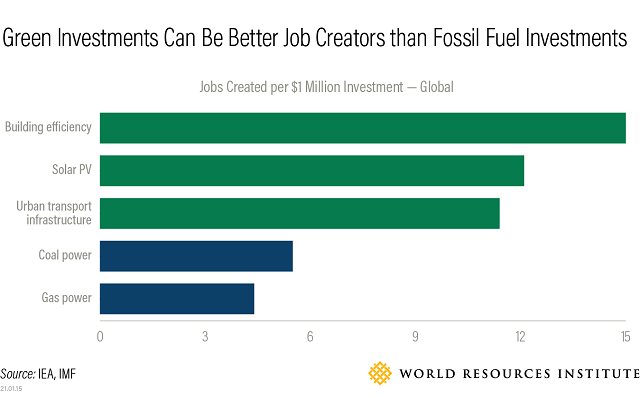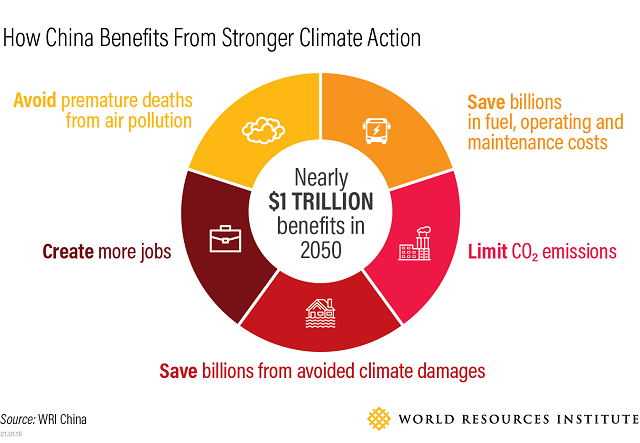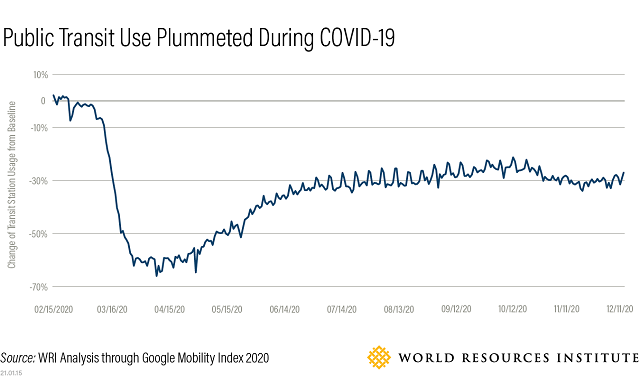
2020 upended life as we know it.
The coronavirus killed almost 2 million people and counting, while roughly 100 million people fell into extreme poverty. The world entered its worst recession since the second world war. Deep-rooted racial and economic injustices were exposed, while the impacts of the pandemic itself fell disproportionately on communities of color. And these crises played out against the ever-present threat of climate change, including record-breaking fires, locust invasions, storms and other extreme weather events.
How the world resets after this unprecedented upheaval will define the year ahead and shape the course of history for years — even decades — to come. As Indian author and activist Arundhati Roy said of the pandemic, “it is a portal, a gateway between one world and the next.”
The question for 2021 is: What kind of world are we entering?
WRI President and CEO Andrew Steer addressed this question at Stories to Watch, WRI’s flagship event where he outlines the moments, trends and people that will affect the environment and international development in the year ahead. The stakes feel higher than ever before in 2021.
“By the end of this year, we will know what kind of civilization we really are,” Steer said.
After the Coronavirus Pandemic: How Will the World Reset?
Indeed, the world’s “Great Reset” after COVID-19 is the backdrop against which all other moments will occur this year. Signals in 2021 will show whether we’re heading toward a cleaner, fairer, stronger world, or moving in the opposite direction.
Here are six indicators to watch throughout 2021 to better understand our direction of travel as the world begins to recover from COVID-19 and the economic fallout:
Biggest Economic Stimulus in History
Countries already allocated $13 trillion to reboot economies, and are likely to spend trillions more in the coming year. Will these funds support clean, low-carbon projects or dirty, fossil fuel-based infrastructure? Will they promote greater equity or continue to exacerbate the social divide?
Research shows that a green stimulus makes economic sense. Investing in building efficiency, for example, creates almost 3-4 times as many jobs per $1 million spent as investment in coal and gas. And yet since COVID-19 began, G20 countries have committed $240 billion to fossil fuels and only $184 billion to clean energy.

The EU emerged as a global leader with its landmark green deal, investing in climate-friendly initiatives and a just transition. Incoming U.S. President Biden vowed to similarly support green, fair growth when he takes office.
Watch whether other countries, both large economies and developing ones, as well as other international development institutions follow this approach to ensure the world is more resilient after COVID-19.
U.S. Climate Action Under a Biden-Harris Administration
President Trump moved the world’s second-largest emitter in the wrong direction on climate change, including rolling back regulations on power plants, vehicles and more. Incoming President Joe Biden and Vice President Kamala Harris promised to right these wrongs by investing $2 trillion in infrastructure and clean energy, achieving 100% clean electricity by 2035, and directing 40% of clean energy funding to disadvantaged communities.
The question is: Will they deliver on these promises and what tools will they use?
“The United States has a lot of catching up to do quite frankly, and simply saying the right things won’t get us there,” Steer said. “And that’s why the first 100 days are so very important.”
Early signs of progress may include rejoining the Paris Climate Agreement, reinstating environmental regulations the Trump administration scrapped, granting California a waiver to set the nation’s strongest clean car standards, issuing an environmental justice executive order and suspending new fossil fuel licenses on federal lands.
Longer term, the United States will need to step up its national climate plan. WRI recommends cutting greenhouse gases 45-50% below 2005 levels by 2030, as well as strengthening adaptation measures. Fostering climate diplomacy internationally — such as by forging a climate deal with India, cooperating with China, and restoring ties with Canada and Mexico — are also important for securing global climate leadership.
The administration also stated a clear commitment to climate and racial justice issues. Following through on this pledge will be critical to ensure the administration succeeds in fostering equity and inclusion.
China’s Priorities in the Year Ahead
China is the only G20 country to boast economic growth in 2020 and is projected to increase its GDP by 8.2% in 2021. The country brought 100 million people out of poverty from 2012-2020. And in late 2020, China announced important new climate targets, including a goal to achieve net-zero emissions by 2060.
Yet on the other side of the equation, China is still the world’s top emitter of greenhouse gases and its largest investor in coal. China will need to take action in the near term to get on zero-carbon path. Several moments this year offer opportunities to do so:
China’s 14th Five-Year Plan, which will begin to be rolled out in March 2021, as well as its new national climate plan (known as a “nationally determined contribution,” or NDC) will send important signals about which direction the country is heading. Will China announce a new year to peak its emissions before 2030; put a cap on coal; and expand emissions-reduction pledges to non-CO2 gases?
China new carbon market will begin trading in February 2021, with a focus on the power sector. How strong will the carbon cap be, and will China expand the market beyond the power sector?
Kunming, China, will host the UN’s major biodiversity summit (COP15) later this year. Will it use the opportunity to green its supply chains? (China is currently the leading importer of beef, soy, and pulp and paper, commodities that drive deforestation and land degradation.)
And finally, will the country set stronger environmental standards for its Belt and Road Initiative, a massive overseas investment initiative spread across 138 countries?

WRI research shows it’s in China’s best interest to pursue ambitious climate action: Taking steps in energy, industry, transportation and carbon capture could save nearly 1.9 million lives and generate nearly $1 trillion in net economic and social benefits in 2050.
Will 2021 be a Breakthrough Year for Nature?
There’s growing recognition of just how essential natural landscapes are for reducing emissions, preserving biodiversity, feeding growing populations and securing economic growth. Recent research by the World Economic Forum found that nature-positive solutions could create 395,000 jobs and $10 trillion in business opportunities by 2030.
Yet we’re heading in the wrong direction. Tropical forest loss increased by 41% annually since 2014.
This year offers many moments for progress, from the UN Food Systems Summit in September 2021 to the G20 meeting in October 2021 to the COP26 climate summit in Glasgow in November 2021 and more. Outcomes aligned with a four-pronged strategy to realize nature’s value are essential:
- Produce: The EU will implement a new Farm to Fork Strategy this year that may inspire other nations. Watch for how the Biden administration incorporates nature into its forthcoming agriculture plan, as well as how countries account for agriculture in their new NDCs.
- Protect: At the UN Conference for Biodiversity in Kunming, nations will make a key decision whether to protect 30% of the world’s land and sea by 2030.
- Reduce: Denmark and Norway are already halfway toward their goals of reducing food waste by 50%. If successful, China’s new Clean Plate campaign will save enough food to feed 60 million people. Will other nations, cities and corporations launch similar initiatives?
- Restore: Countries committed through the Bonn Challenge to restore more than 200 million hectares of degraded lands, with 14 million hectares already underway. Will new advances in monitoring technology — such as WRI’s forthcoming Restoration Watch— spur more action and investment?
Public Transit in the Wake of COVID-19
Public transit ridership plummeted during the coronavirus pandemic. Many transportation systems are now on the verge of collapse.
The EU faces a $50 billion shortfall in public transit funding due to decreased ridership in 2020, while India lost $7 billion in bus revenue.

At the same time, expanding public transit systems is essential for fighting climate change and improving equity. For example, in the United States, Black households are 3 times more likely to lack access to a vehicle than white households. Models show that public transport cuts in sub-Saharan Africa in 2020 were part of the reason an additional 9% of the population went into extreme poverty.
As cities emerge from the COVID-19 crisis, will they prioritize public transit over cars?
Nigeria; Austin, TX; and London, to take just three examples, already announced encouraging public transport initiatives for 2021. More than 200 cities invested in bike lanes and pedestrian walkways since the COVID-19 pandemic began. China boasts 95% of the world’s electric buses. Will other cities and countries similarly push forward on green transport?
International Climate Action and the Road to Glasgow
The past few years brought laudable climate action: 61 countries announced pledges to reach net-zero emissions, more than 1,000 companies set science-based emissions-reduction targets, and more than 10,000 cities joined the Global Covenant of Mayors for Climate & Energy.
The problem is that all this action isn’t yet adding up to enough progress. Recent WRI research shows the world will need to adopt renewable energy 6 times faster, phase out coal 5 times faster and electrify vehicles 22 times faster by 2030 — among other actions — to prevent the worst effects of climate change.
This year could be an inflection point for global climate action, provided the world seizes opportunities across four key areas:
- For one, all countries should release new NDCs by the UN climate summit (COP26) in Glasgow in September 2021. So far, countries have submitted 71 new NDCs, but only 43 are more ambitious than 2015 plans. The EU, UK and Colombia, as well as many smaller developing countries and island nations, are taking the lead. Watch for whether more countries — especially the United States and China — step up their emissions-reduction pledges.
- Climate negotiators at COP26 must finalize important rules of the international Paris Climate Agreement, including those on carbon markets (Article 6), reporting timelines for NDCs, the global stocktake and finance.
- Look to see if the financial sector will further align with the global goal of limiting temperature rise to 1.5 degrees C (2.7 degrees F), the target scientists say is necessary for averting the worst impacts of climate change. This includes developed countries coming through with the $100 billion in annual climate finance they promised to provide, as well as additional commitments, including scaling up finance for adaptation.
- Finally, will the world see a “Race to Zero,” where specific sectors achieve breakthroughs to rapidly decarbonize? Plans to eliminate the internal combustion engine and achieve zero-carbon shipping and zero-carbon buildings would be especially significant.
Listen to the recent episode of WRI’s “Big Ideas Into Action” podcast, where WRI President Andrew Steer looks at the stories to watch in 2021.
Subscribe to the series on SoundCloud or Apple Podcasts.
Want to see the full Stories to Watch presentation? Check out the Stories to Watch video recording and other resources here.
This blog was originally published on WRI’s Insights.
Sarah Parsons is the Senior Editor for World Resources Institute.






